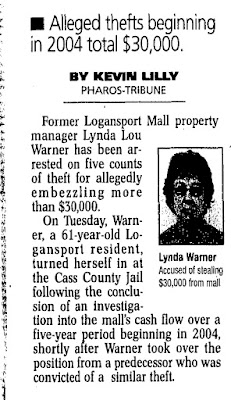Built in 1967 - May 26, 1967 clipping from the Logansport Pharos Tribune and Press, page 1
Photo of the Logansport Mall Sign taken in 1977
List of merchants in a 1977 promotional ad
Just as in any other city, the shopping mall was the place to go for so many reasons, not just shopping. It was a place to see people, have a snack or a sandwich, play acarde games or just get a little exercise by walking laps inside the place.
It was a place to go to get into the holiday spirit, with it's beautiful Christmas tree(s) and lights and decor and Santa's Sleigh and big, comfy chair to greet everyone.
Saturdays were perfect for kids at the mall to hang out. Parents could drop off car loads of their kids and their kids' friends for a couple of hours, much to the chagrin of the mall employees, who resented being made to feel like they had to be responsible "babysitters" for "other people's kids".
So much happened at the local mall. Car shows, coin shows, musical programs, charity auctions, and oh yeah - shopping. Side walk sales were a seasonal thing. Merchants, especailly Sears and J C Penney - the anchor stores - would fill the center aisle of the mall property with racks and tables filled with clothing, shoes and any item sold at any of the stores - all offered at great discounted prices.
During Christmas shopping season, "Black Friday" to Christmas Eve, that center floor space would be filled with seasonal vendors who sold everything from hats to tee shirts to perfumes, candy and Hickory Farms products, to sunglasses.
February 1996 - Twelve Vacancies
Cocerns expressed at a meeting of the Logansport Economic Development Foundation board about vacancies in the mall were published in the Logansport Pharos Tribune. The article was on page 1, February 23, 1996. Terry Alley, Mall manager at that time, confirmed that the property was for sale and that prospective buyers had been looking at it for months. Within the article Alley was quoted, "I'm very optimistic. I think that it (a sale) will happen very soon." and "I think its going to be for the better - a real improvement".
Alley also explained that of the stores that had left the mall, some didn't renew leases as ordered by their corporate managers, but most of the vacancies were due to national chains going bankrupt and other chains just closed their doors.
March 18 1996 - Pharos Tribune
August 1996
The announcement that the mall now had nine vacancies instead of twelve and the opening of a fashion store called Stage was encouraging. (Below is an excerpt from the article. Pharos Tribune August 11, page 1.)
Two Mall Managers were arrested, at different times, for theft. Deedee Blume was hired as manager in 1998.
2003
On September 24, 2003 the Pharos Tribune page 1 headline read
"Former Mall Manager Charged With Theft". Above is a clipping of the sub headline.
April 9, 2004, Pharos Tribune, page 1
Lynda Warner became Interim Manager in 2003 after Blume's arrest. Ironically, Warner was, herself, arrested for theft in 2009.
2009
June 4, 2009 Pharos Tribune, page 1
Store spaces began to empty in the mid to late 1990s. By July 12, 2015 the public was being asked for ideas for the Mall property. Below: clip from Pharos Tribune July 12, 2015.
This story is not finished. It is history in the making.
The fountain at the main entrance.


















































